"A microchip is a radio-frequency identification transponder that has a unique identification number."
Chip your pet month
It is a horror for us pet parents when our pets get lost or try to escape. And it's even a greater horror when we haven't kept their ID tags updated or when their tags get lost along the way.
The best way to avoid these problems? Microchip.
In honor of May being National Chip Your Pet Month, we'll spell out what microchipping is and why it's important.
What is a microchip?
A microchip is a radio-frequency identification transponder that has a unique identification number. Where do they put microchips in pets? It is then implanted on your pet under the loose skin between the shoulder blades. If a vet scans your pet's microchip, it sends and shows the ID number.
Do Pets Need Microchipped?
When your pet's microchip is registered to a national pet recovery database, your contact information will also be registered. So if ever your pet gets lost and found, you don't want to miss that call.
In scanning a microchip, a handy scanner reads the radio frequency of the chip and shows the registered information. The animal shelter or the vet clinic that found your pet can then contact the registry to get your name and contact details.
But while microchipping is not a 100% guarantee that your pet will be returned (or found), having him chipped is a safety precaution that most responsible pet owners often resort to. For example, it greatly helps when proving ownership of your pet if he ever falls into the hands of the wrong people.
The advantages of microchipping your pet
- As mentioned above, microchipping does not guarantee your pet is 100% lost proof, but at least it increases your chances of being reunited with your pet again after you've been separated.
- Microchipping helps protect your pet from being stolen and then from being sold. It is an efficient way to identify your pet because microchips cannot be tampered. If you changed contact numbers, you need to update your pet’s microchip registration. Go to the microchip manufacturer’s database and make sure everything is updated. You’ll need the microchip’s registration number to update information. If you forgot, you can have it scanned by your veterinarian.
- You will have peace of mind to let your pet come and go through the pet door to have fun outside. There are pet doors available that only works with your pet's microchip and you can have them custom-made from certain pet door manufacturers. So it also saves you from having to worry about stray animals going in your house.
Health risks you need to be aware of
Cancer. A number of cases have been reported that aggressive tumor growths appeared on the microchip's site. Though the risk of cancer is low, it's still best to be aware about the risks before going with the procedure.
Moving microchips. Some cases have been reported that of microchips migrating from the pet's shoulder blades down to his belly. If this happens, there will be a need to remove the microchip through surgery. To be able to prevent this from happening, have your vet scan it every two weeks. Or you can also feel the microchip on the implant site to make sure it's still there.


Adverse reactions. Some pets have also been reported to have unusual reactions with the microchip, from having inflammations to developing tumors.
If you observe your dog having some adverse reactions after implant, consult your vet immediately.
If you decide to proceed with the procedure, microchipping is affordable and feels just like an ordinary vaccination that's why it can be done within the day.
So the next time your dog walks out that pet door for playtime or for fun in the sun, your mind is at peace knowing he is secured.









